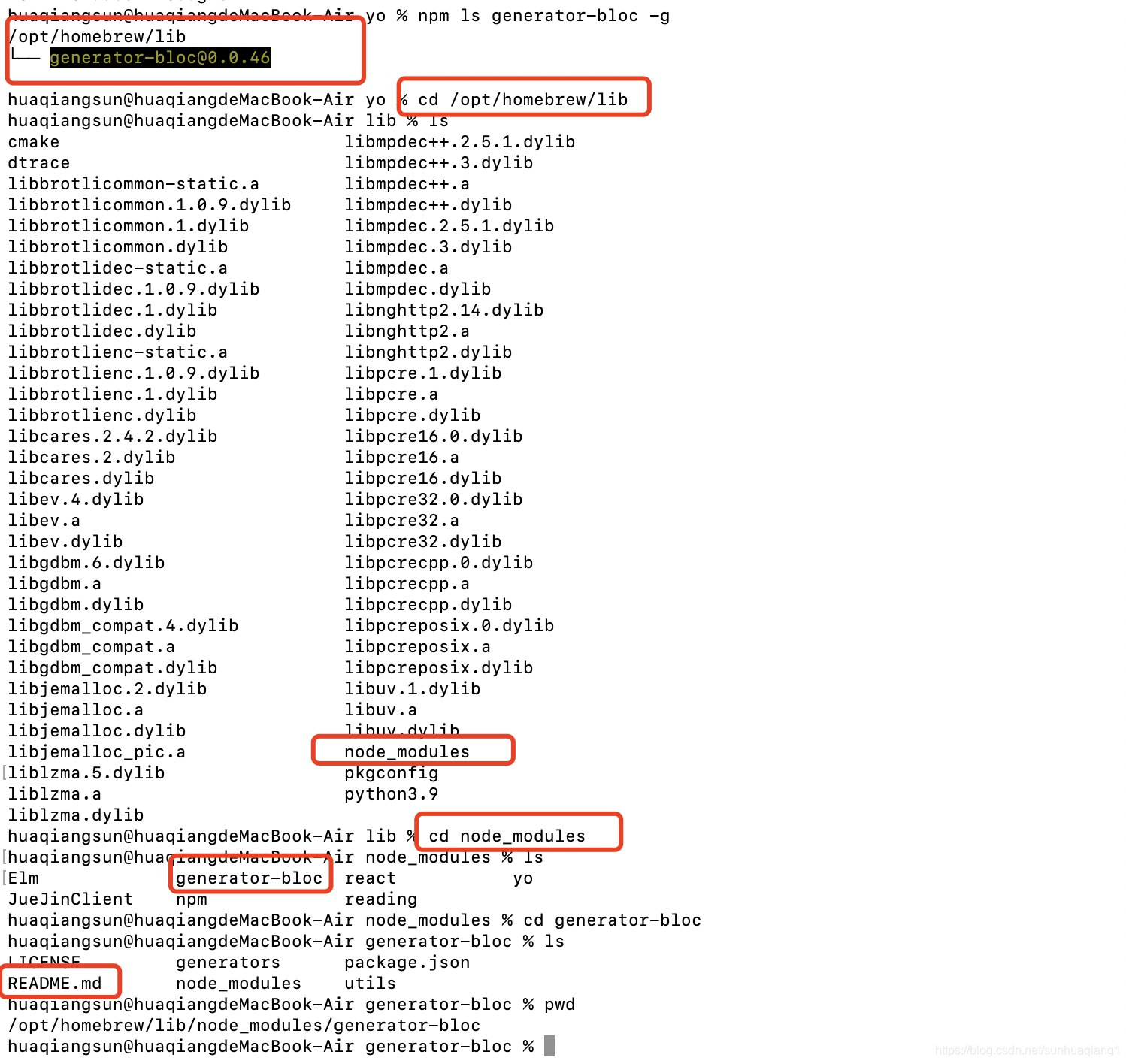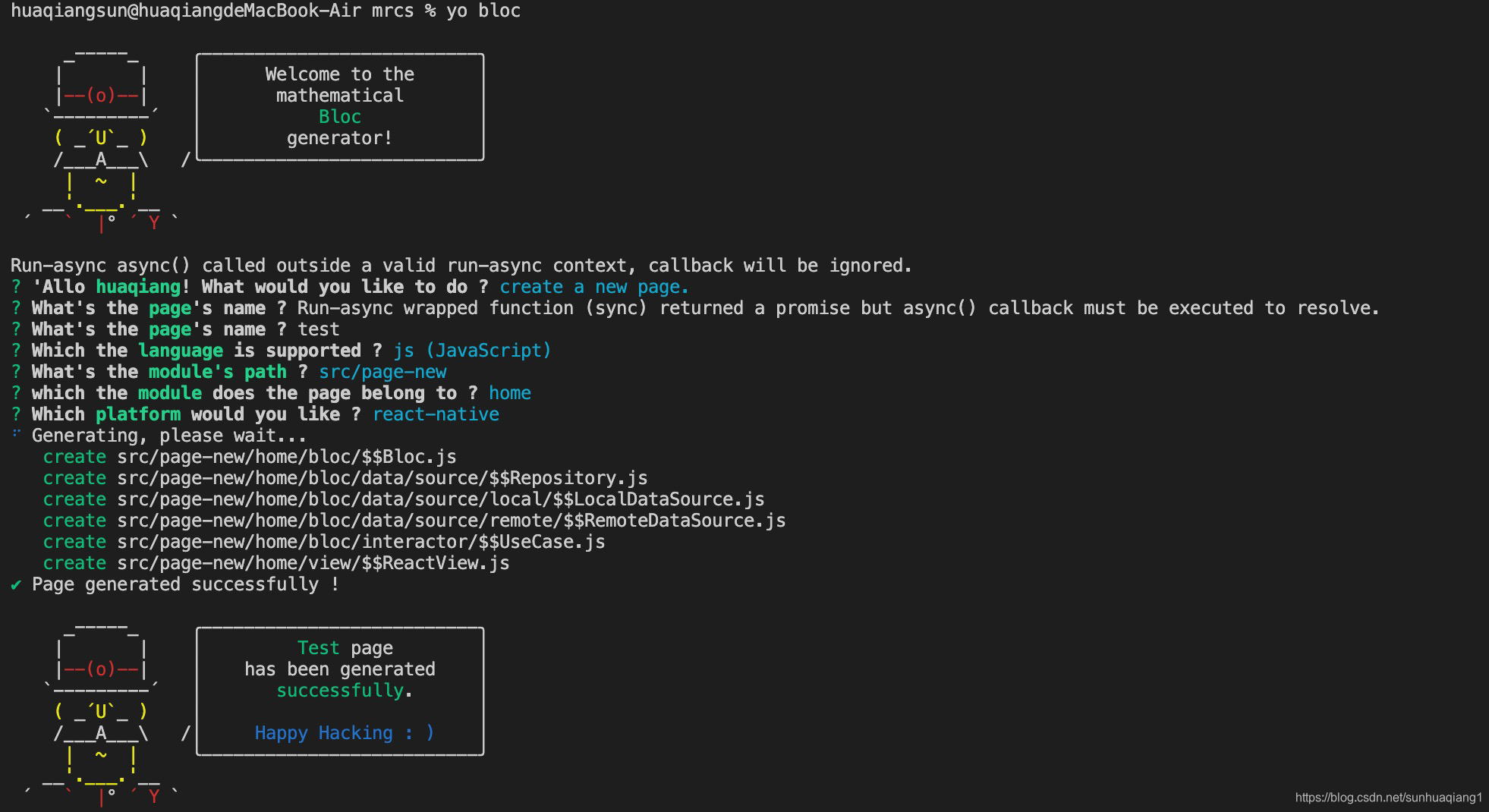ReactNative进阶(三十五):应用脚手架Yo构建RN页面
一、前言
前期将脚手架yo安装成功,本篇博文主要讲解如何利用yo提供的代码自动生成功能生成项目代码,话不多说,开干!
二、Bloc数据流讲解
Bloc数据流工具安装:
sudo npm install -g yo
sudo npm install -g generator-bloc
- 1
- 2
安装完成后通过执行 npm ls generator-bloc -g 命令,查看bloc模板生成位置。执行结果如下:

进入node_modules目录,可看到生成的generator-bloc文件夹,进入该文件夹,查看README.md文件。
文件内容如下:
> # generator-bloc [![NPM version][npm-image]][npm-url] [![Build Status][travis-image]][travis-url] [![Dependency
> Status][daviddm-image]][daviddm-url] [![Coverage
> percentage][coveralls-image]][coveralls-url]
> > react-bloc cli
>
> ## Installation
>
> First, install [Yeoman](http://yeoman.io) and generator-bloc using
> [npm](https://www.npmjs.com/) (we assume you have pre-installed
> [node.js](https://nodejs.org/)).
>
> ```bash npm install -g yo npm install -g generator-bloc ```
>
> Then generate your new project:
>
> ```bash yo bloc ```
>
> ## Getting To Know Yeoman
>
> * Yeoman has a heart of gold.
> * Yeoman is a person with feelings and opinions, but is very easy to work with.
> * Yeoman can be too opinionated at times but is easily convinced not to be.
> * Feel free to [learn more about Yeoman](http://yeoman.io/).
>
> ## License
>
> MIT © [MeePwn](https://github.com/maybewaityou)
>
>
> [npm-image]: https://badge.fury.io/js/generator-bloc.svg [npm-url]:
> https://npmjs.org/package/generator-bloc [travis-image]:
> https://travis-ci.org/maybewaityou/generator-bloc.svg?branch=master
> [travis-url]: https://travis-ci.org/maybewaityou/generator-bloc
> [daviddm-image]:
> https://david-dm.org/maybewaityou/generator-bloc.svg?theme=shields.io
> [daviddm-url]: https://david-dm.org/maybewaityou/generator-bloc
> [coveralls-image]:
> https://coveralls.io/repos/maybewaityou/generator-bloc/badge.svg
> [coveralls-url]: https://coveralls.io/r/maybewaityou/generator-bloc
- 1
- 2
- 3
- 4
- 5
- 6
- 7
- 8
- 9
- 10
- 11
- 12
- 13
- 14
- 15
- 16
- 17
- 18
- 19
- 20
- 21
- 22
- 23
- 24
- 25
- 26
- 27
- 28
- 29
- 30
- 31
- 32
- 33
- 34
- 35
- 36
- 37
- 38
- 39
- 40
- 41
三、利用代码自动生成功能创建新页面
此处以新建test界面为例介绍使用bloc创建界面的方法步骤,页面新建在项目中page-new目录下。
- 进入项目根目录输入命令:
yo bloc回车; - 弹出选择界面后使用上下移动键选择:
create a new page. 回车; - 输入页面名字:test 回车;
- 选择语言:
js回车; - 输入模块路径:
src/page-new回车; - 选择新建页面所在的模块:
home回车; - 选择平台:
react-native回车; - 待页面创建完成,未报错则说明页面创建成功;

通过以上步骤信息结合项目结构可知,
-
脚手架yo为我们新生成了
home/view/TestView.js、 home/bloc/TestBloc.js、home/bloc/interactor/TestUserCase.js、home/bloc/data/source/TestRepository.js、home/bloc/data/source/local/TestLocalDataSource.js、home/bloc/data/source/remote/TestRemoteDataSource.js等文件。 -
在
home/bloc/ioc/types.js文件中新增bloc标识:
export const DATA_SOURCE_TYPES = {
HomeRemoteDataSource: Symbol.for('HomeRemoteDataSource'),
HomeLocalDataSource: Symbol.for('HomeLocalDataSource'),
TestRemoteDataSource: Symbol.for('TestRemoteDataSource'),
TestLocalDataSource: Symbol.for('TestLocalDataSource'),
};
- 1
- 2
- 3
- 4
- 5
- 6
- 7
export const USE_CASE_TYPES = {
HomeUseCase: Symbol.for('HomeUseCase'),
TestUseCase: Symbol.for('TestUseCase'),
};
- 1
- 2
- 3
- 4
export const REPOSITORY_TYPES = {
HomeRepository: Symbol.for('HomeRepository'),
TestRepository: Symbol.for('TestRepository'),
};
- 1
- 2
- 3
- 4
export const BLOC_TYPES = {
HomeBloc: Symbol.for('HomeBloc'),
TestBloc: Symbol.for('TestBloc'),
};
- 1
- 2
- 3
- 4
- 在
bloc/ioc/register.js文件中新增容器配置:
import TestBloc from '../TestBloc';
import TestUseCase from '../interactor/TestUseCase';
import TestRepository from '../data/source/TestRepository';
import { TestRemoteDataSource } from '../data/source/remote/TestRemoteDataSource';
import { TestLocalDataSource } from '../data/source/local/TestLocalDataSource';
container.bind(DATA_SOURCE_TYPES.TestRemoteDataSource).to(TestRemoteDataSource);
container.bind(DATA_SOURCE_TYPES.TestLocalDataSource).to(TestLocalDataSource);
container.bind(REPOSITORY_TYPES.TestRepository).to(TestRepository);
container.bind(USE_CASE_TYPES.TestUseCase).to(TestUseCase);
container.bind(BLOC_TYPES.TestBloc).to(TestBloc);
- 1
- 2
- 3
- 4
- 5
- 6
- 7
- 8
- 9
- 10
- 11
- 在
home/route-config/HomeRouteConfig.js将新建页面添加到路由中;
将TestView添加到export中即可使用router.navigate(“TestView”)跳转到该页面。
注:本项目路由使用router:import { router } from 'mario-navigation-extension';
四、Bloc数据流使用说明

bloc数据流采用stream-builder的形式绑定数据,当stream绑定的数据有改变时,builder便会重新渲染界面,类似于RN的setState,下面以刚创建的TestView为例介绍使用步骤:
- 首先,该页面的入口文件为
src/page-new/view/TestView.js, 该界面只写view相关的代码,export default ( ) ...方法即为页面入口,该方法可接收路由传递的参数,可在此方法完成参数初始化,如果该页面需要在未被销毁的情形下多次加载,可以使用try catch初始化,container.get(BLOC_TYPES.TestBloc)方法会完成bloc的唯一注册,只会在第一次初始化时渲染界面,重新渲染需要使用BlocProvider.of(BLOC_TYPES.TestBloc),因此多次加载同一界面可以使用如下代码:
export default (props) => {
let _bloc = null;
try { _bloc = BlocProvider.of(BLOC_TYPES.TestBloc);
} catch (error) { _bloc = container.get(BLOC_TYPES.TestBloc);
}
const params = props.navigation.state.params;
_bloc.init(params);
return <BlocProvider bloc={_bloc} child={_viewBuilder} />;
};
- 1
- 2
- 3
- 4
- 5
- 6
- 7
- 8
- 9
- 10
- 11
其中init方法在TestBloc中定义。
- 接下来便是
_viewBuilder中的界面UI:
function _viewBuilder() {
const _bloc = BlocProvider.of(BLOC_TYPES.TestBloc);
return ( <View style={style.container}> <StreamBuilder stream={_bloc.viewState$} builder={_testBuilder} /> <StreamBuilder stream={_bloc.listData$} builder={_listBuilder} /> </View>
);
}
- 1
- 2
- 3
- 4
- 5
- 6
- 7
- 8
- 9
其中stream为TestBloc中定义的数据,builder为界面UI,builder会获取绑定数据的快照snapshot,snapshot.data即为绑定的数据。
function _testBuilder(snapshot){
if(snapshot.hasData){ return ( <Text>{JSON.stringify(snapshot.data)}</Text> )
} else return ( <View></View>
)
}
- 1
- 2
- 3
- 4
- 5
- 6
- 7
- 8
- 9
- 10
stream可以绑定多个数据流:
<StreamBuilder stream={_bloc.listData$.pipe(combineLatest(_bloc.searchObj$))} builder={_userListBuilder} />
- 1
- 页面数据定义在
src/page-new/home/bloc/TestBloc.js中,
listData = { viewState: { isRefresh: false, isLoading: true, hasMore: true, hint: '加载中...', pageNo: '1', pageSize: '15', }, list: [], data: {},
};
listData$ = new EnhanceSubject(this.listData); viewState = { open: false, pickerItems: [{ text: '待发货', handleFlag: '1' }, { text: '已发货', handleFlag: '2' }], pickedItem: { text: '待发货', handleFlag: '1', }, totalSize: 0,
};
viewState$ = new EnhanceSubject(this.viewState);
- 1
- 2
- 3
- 4
- 5
- 6
- 7
- 8
- 9
- 10
- 11
- 12
- 13
- 14
- 15
- 16
- 17
- 18
- 19
- 20
- 21
- 22
- 23
- 24
listData$即为TestView例绑定的数据,当listData$改变时界面就会重新渲染,例如:
init = (params) => { this.listData= processModify(this.listData, { viewState: { isRefresh: params.isRefresh, isLoading: params.isLoading, hint: '加载中...' }, }); this.listData$.add(this.listData); // 相当于RN的setState
};
- 1
- 2
- 3
- 4
- 5
- 6
- 7
- 8
- 9
- 10
!注:定义在TestBloc中的方法建议使用箭头函数,防止
this指向跑偏。
- 网络请求使用封装好的WebService:
src/main/service/WebService.js,WebService的BaseUrl为:src/main/constant/Constant.js:BASE_URL,请求参数有个meta数据,该meta数据会在真正请求前删除,使用meta: { silence: true }可以在请求时不展示Loading框,默认会加载Loading框
在bloc中定义异步接口方法,
queryList = async (refresh, handleFlag) => { let index = refresh ? '1' : this.listData.viewState.pageNo; this.listData = processModify(this.listData, { viewState: { ...this.listData.viewState, isRefresh: refresh, isLoading: !refresh, hint: '加载中...' }, }); this.listData$.add(this.listData); // 发起请求时刷新界面状态
// 使用userCase调用接口,返回的是两个对象,第一个为接口报错(非业务逻辑错)时的对象,第二个为接口正常返回的对象 const [error, data] = await this.useCase.execute({ bizline: '4', tasktyp: '25', handleFlag: handleFlag || this.viewState.pickedItem.handleFlag, pageNo: index, pageSize: this.listData.viewState.pageSize, meta: { silence: true }, }); if (error) { ... this.listData$.add(this.listData); // 接口报错时更新界面UI return; } let hasList = this.listData.list || []; if (refresh) { hasList = []; } let list = data.resultList; let isMore = list.length >= parseInt(this.listData.viewState.pageSize); let hint = ''; if (hasList.length < 1 && list.length < 1) { hint = '抱歉~没有相关信息'; } this.listData = processModify(this.listData, { list: hasList.concat(list), data, viewState: { ...this.listData.viewState, isRefresh: false, isLoading: false, hasMore: isMore, pageNo: `${parseInt(index) + 1}`, hint: hint || (isMore ? '加载更多' : '没有更多了'), } }); this.listData$.add(this.listData); // 请求得到后台数据后刷新界面数据 this.viewState = processModify(this.viewState, { totalSize: data.totalSize, }); this.viewState$.add(this.viewState); // 刷新界面状态
};
- 1
- 2
- 3
- 4
- 5
- 6
- 7
- 8
- 9
- 10
- 11
- 12
- 13
- 14
- 15
- 16
- 17
- 18
- 19
- 20
- 21
- 22
- 23
- 24
- 25
- 26
- 27
- 28
- 29
- 30
- 31
- 32
- 33
- 34
- 35
- 36
- 37
- 38
- 39
- 40
- 41
- 42
- 43
- 44
- 45
- 46
- 47
- 48
- 49
- 50
- 51
- 52
- 53
添加:
buildUseCasePromise(params) { return this.repository.queryList(params);
}
- 1
- 2
- 3
添加接口参数,也就是this.useCase.execute传过来的参数,userCase的excute方法执行的是buildUseCasePromise方法,如果是其它方法需要自定义:
handleCheck(params) { return to(this.repository.handleCheck(params));
}
- 1
- 2
- 3
此时需要将结果用to包裹,以规范返回数据的格式:
import { to } from '../../../../main/utilities';
- 1
调用自定义方法时,需要将bloc里的调用方法由this.useCase.execute({})改为this.useCase.handleCheck({});
然后定义数据流策略,使用远程服务器数据还是本地数据库数据(定义在src/page-new/home/bloc/data/source/TestRepository.js:):
queryList(params) { return this.remoteDataSource.queryList(params);
}
- 1
- 2
- 3
在该处可以进行数据的并行或者串行请求或者数据的其它一些处理:
async queryList(params) { const data = await this.remoteDataSource.queryList({ meta: { silence: true } }); if (data.list.length > 0) { let customeridStr = ''; data.list.forEach((item) => { customeridStr += item.customerid + ','; }); // 串行接口 const signalData = await this.remoteDataSource.queryNewsTheme( { customeridStr, flag: 'index', ...params, meta: { silence: true } }); let listIndex = [] for (let i = 0; i < signalData.listIndex.length; i++) {
... } return { totalSize: signalData.totalSize, listIndex }; } else { return { 'listIndex': [] } }
}
- 1
- 2
- 3
- 4
- 5
- 6
- 7
- 8
- 9
- 10
- 11
- 12
- 13
- 14
- 15
- 16
- 17
- 18
- 19
最后就是调用webService请求后台接口:
queryList(params) { return this.webService.request(queryTaskPageList, params);
}
- 1
- 2
- 3
其中params是传过来的,queryTaskPageList为接口名称,需要自定义:
const queryTaskPageList = 'queryTaskPageList';
- 1
数据流如下图所示:

拓展阅读
- 《ReactNative进阶(三十二):前端构建工具–Yeoman》
- 《ReactNative进阶(三十一): IoC 框架 InversifyJS解读》
- 《ReactNative进阶(二十九):BloC模式》
文章来源: shq5785.blog.csdn.net,作者:No Silver Bullet,版权归原作者所有,如需转载,请联系作者。
原文链接:shq5785.blog.csdn.net/article/details/117185409
- 点赞
- 收藏
- 关注作者



评论(0)